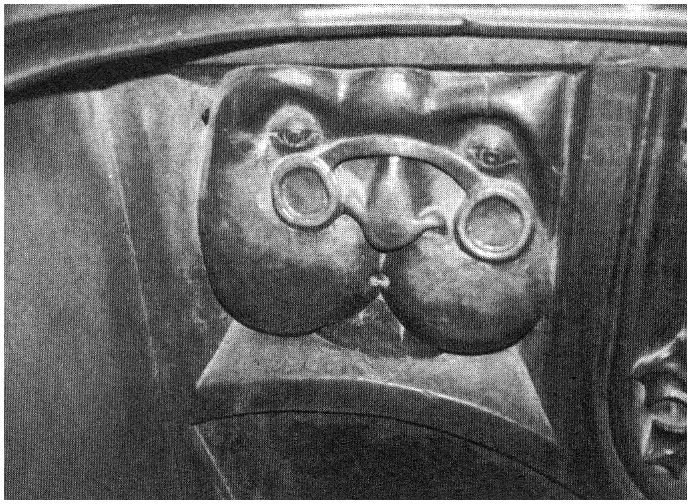
Medieval
Obscenities
Nicola McDonald,
Editor
(University of York)

Well, we knew there were some sizzling passages in Chaucer's Canterbury Tales, and we suspected there might be some rustic by-play in Dante's Divine Comedy, but even our best teachers didn't tell us about the suspected rape in the Roman de la Rose, and we certainly never heard of "Sir Stiffy" (En Montan) in songs of the troubadors.Michelin's Guide Rouge to Leon didn't suggest we look at the choir stall at the cathedral where there is a bespectacled bare bottom, According to Michael Camille, "when the stall was occupied, this face was squeezed up against a canon's big rear end." [See Figs. 1 and 2]. Michelin's guide to the Loire Valley also did little to advise us to look for the "bottom with acanthus," bare bum hanging out, literally, on the cathedral at Bourges.
But here they are. As the late art historian Camille tells us, there was no such word as "obscene" in medieval French. The bum, he says, was literally the "site of power."
As anyone who had ever been constipated knows, there is nothing wrong with shitting and most medieval sculptural representations concern inducing rather than stopping it.
The bare bum "was not shocking to its medieval audience, precisely because it did not represent the defiling or penetrating of the vulnerable and highly sexualized male body." But, he continues,
I think it is too easy to sentimentalize medieval obscenity whether it be in Chaucer or these sculptures, to make them part of a 'weren't they open-minded then' sort of view.
"The theatre of the anus was always open for performance, both inside and outside the Church, and it was a serious business even when it was meant to make us laugh."
§ § § There are ten contributors to Medieval Obscenities, and they are a respectable bunch, coming to us from such places as St. John's College, Oxford, University of Chicago, University of York, and the National Museum of Ireland. It is our own conditioning, as further enhanced by television and movies, that makes us think that professors have to be stuffy and dull. Forget it. What they write here is a lot of fun.
There are, as Eamonn Kelly reports, "sheela-na-gigs" of Ireland: "grotesque sculptures of naked females," stone carvings on churches and on doorways, as well as ivory and copper pipe tampers. Emma Dillon gives us the low-down on "rude noises" trumpeting through the Divine Comedy.
Glenn Davis writes on erotic riddles in Beowulf, the Life of Saint Mary and the Old English Penitential. Jeremy Goldberg examines records of church courts for a chapter on "Voyeurism and 'Pornography,' in Late Medieval England," and Simon Gaunt convinces us that some troubadour lyrics might be seen as the progenitors of rap; viz., this lyric from Guilhem IX:
I'm well aware of the difference
between sense and folly, and know
shame and honour, and feel boldness
and fear; and if you propose a game of
love to me, I'm not so simple-minded as
not to know how to choose the better
from the bad ones.§ § §
The editor, Nicola McDonald, observes that the language used in this volume would not have been condoned "until relatively recently." However,
A three-centimetre tall, crowned and mounted caricature of a vulva, armed with whip and crossbow, from the last fourteenth or early fifteenth century and designed to be worn, defies modern interpretation ... As soon as we give it a name --- "Vulva on Horseback," "Pussy Goes A Hunting" or simply "Louise," [quoting from a catalogue of "Billy and Charlie's Pewter Goods" of Malvern, Pennsylvania] we initiate the discursive process (as I have already done in this introduction), [and] immediately betray, and are in turn limited by, our own interpretation and our own agenda.
As Barry Goldwater "so memorably (and impossibly) put it:" As a father and a grandfather I know, by golly, what is obscene and what isn't. "Obscenity," McDonald concludes, "is culturally and temporally specific."
--- Lolita Lark